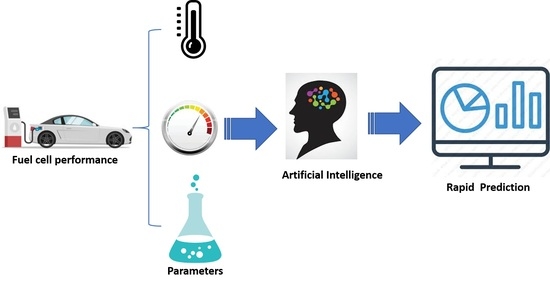A Critical Review on Artificial Intelligence for Fuel Cell Diagnosis
Abstract
:1. Introduction
1.1. Fuel Cells (FCs)
1.2. Types of FCs
1.3. Components of FC
1.3.1. Electrocatalyst
1.3.2. State of Health of FC
- At low power densities, the cell potential drops as a result of the activation polarization.
- Due to ohmic losses, the cell potential drops linearly with the current at moderate current densities.
- At high current densities, the cell potential drop deviates from the linear relationship with current density due to stronger concentration polarization.
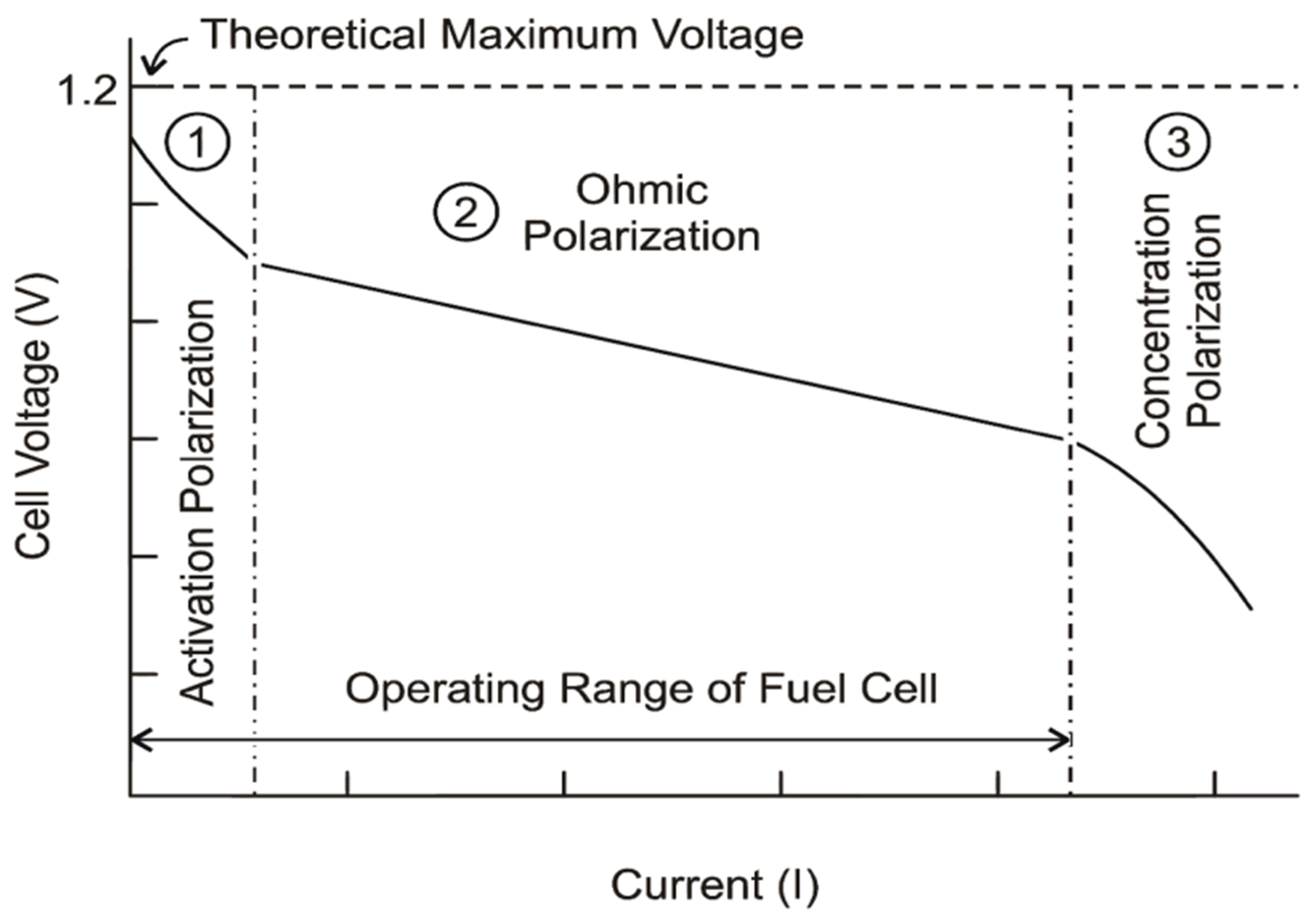
1.4. Artificial Intelligence (AI)
2. Methodology and Structure
3. Common AI Methods Used in FC
3.1. Artificial Neural Network
3.2. Genetic Algorithm
3.3. Particle Swarm Optimization
3.4. Random Forest
3.5. Support Vector Machine
3.6. Extreme Learning Machine
4. Summary and Outlook for Future
- The computational models of transport events inside a solid oxide FC anode were examined.
- The grey wolf optimizer is utilized, which has rapid, sturdy, and simple properties.
- A novel optimization method for automatically collecting characteristics from the impedance spectra of polymer electrolyte membrane FCs was observed.
- A neural network method used to determine the voltage and current of a PEMFC was summarized.
- A technique to improve the performance and durability of an FC by predicting the local current distribution was also discussed.
- The energy management strategy for an FC hybrid electric vehicle with an FC as the primary power source and a battery as a backup power source was illustrated.
- A GA-based optimized rule-based EMS for optimal power allocation between the FC and the battery system was explored.
- An effective method for controlling the flow channel design of the bipolar plate (BPP) was devised to obtain the greatest performance of PEMFCs.
- GA was used to improve a high-temperature PEMFC’s flow channel.
- The voltage degradation for PEMFC under various conditions is projected using a new prognostics approach based on GA, and an extreme learning machine (ELM) was explained.
- A novel grey neural network model (GNNM) strategy in which GNNM is combined with particle swarm optimization (PSO) and the moving window method to predict PEMFC degradation under various operating conditions was described.
- For optimal parameter estimations, chaos-embedded particle swarm optimization was used to model polymer electrolyte membrane FCs.
- The comparison and contrast of two Maximum Power Point Tracking (MPPT) strategies, one based on the Mamdani Fuzzy Inference System and the other on the PSO algorithm, to keep the output power of an FC stack extraordinarily near to its peak was discussed.
- An optimization approach for scaling the modules of a PEMFC-battery hybrid energy system (HES) to provide the required driving force for passenger trains was illustrated.
- A simplified form of the competitive swarm optimizer (SCSO) was introduced to deal with the parameter identification challenge of SOFC models. The flow channel of a high-temperature PEMFC was optimized using GA.
- An improved PCA approach was employed to create the essential features of RF and Support Vector Regression to evaluate two efficient ML algorithms.
- An ensemble model based on a stacked extended short-term memory model that integrates three machine-learning models, including long short-term memory with attention mechanism, support vector regression, and random forest regression, to improve the deterioration prediction of a PEMFC stack was explained.
- A detailed performance evaluation and a random forest prediction technique to examine system energy optimization in order to improve the stability, real-time performance, and economy of the PEMFC hybrid welding robot system were carried out.
- To predict the performance of a PEMFC system in a widely available electronic bicycle using SVM.
- The link between power density and operational parameters such as operating temperature, FC pressure, anode relative humidity, cathode relative humidity, GDE porosity, and GDE conductivity was established using SVM modeling analysis of PEMFC performance. The optimum design of a power density model for PEMFCs was also performed with SVM.
- A nonlinear modeling investigation of an SOFC stack using a least-squares support vector machine was illustrated.
- A dynamic temperature model of an SOFC using least-squares support vector machines in order to build effective temperature management techniques using model-based control approaches has also been portrayed.
- Extract unknown characteristics of solid oxide fuel cell models, including electrochemical models and simple electrochemical models.
- Forecast a novel prognostics method based on GA and ELM for the voltage deterioration in PEMFC under various situations.
- Optimal and efficient modeling of proton-exchange membrane fuel cells using a hybrid technique based on CNN and ELM networks.
Author Contributions
Funding
Institutional Review Board Statement
Informed Consent Statement
Data Availability Statement
Acknowledgments
Conflicts of Interest
References
- Philibert, C.; Frankl, P.; Tam, C.; Abdelilah, Y.; Bahar, H.; Marchais, Q.; Wiesner, H. Technology Roadmap: Solar Photovoltaic Energy, 2014 ed.; International Energy Agency: Paris, France, 2014; pp. 1–60. Available online: https://www.iea.org/reports/technology-roadmap-solar-photovoltaic-energy-2010 (accessed on 10 May 2022).
- Dincer, I.; Acar, C. A review on clean energy solutions for better sustainability. Int. J. Energy Res. 2015, 39, 585–606. [Google Scholar] [CrossRef]
- Zou, C.; Zhao, Q.; Zhang, G.; Xiong, B. Energy revolution: From a fossil energy era to a new energy era. Nat. Gas Ind. B 2016, 3, 1–11. [Google Scholar] [CrossRef] [Green Version]
- Mehta, V.; Cooper, J.S. Review and analysis of PEM fuel cell design and manufacturing. J. Power Sources 2003, 114, 32–53. [Google Scholar] [CrossRef]
- Nguyen, T.; Lin, G.; Ohn, H.; Hussey, D.; Jacobson, D.; Arif, M. Measurements of two-phase flow properties of the porous media used in PEM fuel cells. ECS Trans. 2006, 3, 415. [Google Scholar] [CrossRef]
- Sazali, N.; Wan Salleh, W.N.; Jamaludin, A.S.; Mhd Razali, M.N. New perspectives on fuel cell technology: A brief review. Membranes 2020, 10, 99. [Google Scholar] [CrossRef] [PubMed]
- Fuel Cells. Available online: http://www.fuelcelltoday.com/analysis (accessed on 10 May 2022).
- Vinodh, R.; Atchudan, R.; Kim, H.-J.; Yi, M. Recent Advancements in Polysulfone Based Membranes for Fuel Cell (PEMFCs, DMFCs and AMFCs) Applications: A Critical Review. Polymers 2022, 14, 300. [Google Scholar] [CrossRef]
- Sprague, I.; Dutta, P. Role of the diffuse layer in acidic and alkaline fuel cells. Electrochim. Acta 2011, 56, 4518–4525. [Google Scholar] [CrossRef]
- Song, C. Fuel processing for low-temperature and high-temperature fuel cells: Challenges, and opportunities for sustainable development in the 21st century. Catal. Today 2002, 77, 17–49. [Google Scholar] [CrossRef]
- Kordesch, K.; Hacker, V.; Gsellmann, J.; Cifrain, M.; Faleschini, G.; Enzinger, P.; Fankhauser, R.; Ortner, M.; Muhr, M.; Aronson, R.R. Alkaline fuel cells applications. J. Power Sources 2000, 86, 162–165. [Google Scholar] [CrossRef]
- Vishnyakov, V. Proton exchange membrane fuel cells. Vacuum 2006, 80, 1053–1065. [Google Scholar] [CrossRef]
- McGrath, K.M.; Prakash, G.S.; Olah, G.A. Direct methanol fuel cells. J. Ind. Eng. Chem. 2004, 10, 1063–1080. [Google Scholar]
- Sammes, N.; Bove, R.; Stahl, K. Phosphoric acid fuel cells: Fundamentals and applications. Curr. Opin. Solid State Mater. Sci. 2004, 8, 372–378. [Google Scholar] [CrossRef]
- Dicks, A.L. Molten carbonate fuel cells. Curr. Opin. Solid State Mater. Sci. 2004, 8, 379–383. [Google Scholar] [CrossRef]
- Jacobson, A.J. Materials for solid oxide fuel cells. Chem. Mater. 2010, 22, 660–674. [Google Scholar] [CrossRef]
- Fan, L.; Tu, Z.; Chan, S.H. Recent development of hydrogen and fuel cell technologies: A review. Energy Rep. 2021, 7, 8421–8446. [Google Scholar] [CrossRef]
- Mekhilef, S.; Saidur, R.; Safari, A. Comparative study of different fuel cell technologies. Renew. Sustain. Energy Rev. 2012, 16, 981–989. [Google Scholar] [CrossRef]
- Solid Oxide Fuel Cell. Available online: https://en.wikipedia.org/wiki/Solid_oxide_fuel_cell (accessed on 10 May 2022).
- Winter, M.; Brodd, R.J. What are batteries, fuel cells, and supercapacitors? Chem. Rev. 2004, 104, 4245–4270. [Google Scholar] [CrossRef] [Green Version]
- Hassan, N. Catalytic performance of nanostructured materials recently used for developing fuel cells’ electrodes. Int. J. Hydrog. Energy 2021, 46, 39315–39368. [Google Scholar] [CrossRef]
- Chen, D.; Ran, R.; Zhang, K.; Wang, J.; Shao, Z. Intermediate-temperature electrochemical performance of a polycrystalline PrBaCo2O5+ δ cathode on samarium-doped ceria electrolyte. J. Power Sources 2009, 188, 96–105. [Google Scholar] [CrossRef]
- Yuan, Y.; Zhang, T.; Wang, Z. Preparation of an anion exchange membrane by pyridine-functionalized polyether ether ketone to improve alkali resistance stability for an alkali fuel cell. Energy Fuels 2021, 35, 3360–3367. [Google Scholar] [CrossRef]
- Ferriday, T.B.; Middleton, P.H. Alkaline fuel cell technology-A review. Int. J. Hydrog. Energy 2021, 46, 18489–18510. [Google Scholar] [CrossRef]
- Sun, Z.; Lin, B.; Yan, F. Anion-exchange membranes for alkaline fuel-cell applications: The effects of cations. ChemSusChem 2018, 11, 58–70. [Google Scholar] [CrossRef] [PubMed]
- Perry, M.L.; Fuller, T.F. A historical perspective of fuel cell technology in the 20th century. J. Electrochem. Soc. 2002, 149, S59. [Google Scholar] [CrossRef]
- Fan, L.; Zhao, J.; Luo, X.; Tu, Z. Comparison of the performance and degradation mechanism of PEMFC with Pt/C and Pt black catalyst. Int. J. Hydrog. Energy 2022, 47, 5418–5428. [Google Scholar] [CrossRef]
- Parnière, A.; Blanchard, P.-Y.; Cavaliere, S.; Donzel, N.; Prelot, B.; Rozière, J.; Jones, D.J. Nitrogen Plasma Modified Carbons for PEMFC with Increased Interaction with Catalyst and Ionomer. J. Electrochem. Soc. 2022, 169, 044502. [Google Scholar] [CrossRef]
- Scherzer, A.-C.; Schneider, P.; Herring, P.K.; Klingele, M.; Zamel, N.; Gerteisen, D. Modeling the Morphological Effects of Catalyst and Ionomer Loading on Porous Carbon Supports of PEMFC. J. Electrochem. Soc. 2022, 169, 034509. [Google Scholar] [CrossRef]
- Bai, J.; Ke, S.; Song, J.; Wang, K.; Sun, C.; Zhang, J.; Dou, M. Surface Engineering of Carbon-Supported Platinum as a Route to Electrocatalysts with Superior Durability and Activity for PEMFC Cathodes. ACS Appl. Mater. Interfaces 2022, 14, 5287–5297. [Google Scholar] [CrossRef]
- Hamnett, A. Mechanism and electrocatalysis in the direct methanol fuel cell. Catal. Today 1997, 38, 445–457. [Google Scholar] [CrossRef]
- Kaur, A.; Kaur, G.; Singh, P.P.; Kaushal, S. Supported bimetallic nanoparticles as anode catalysts for direct methanol fuel cells: A review. Int. J. Hydrog. Energy 2021, 46, 15820–15849. [Google Scholar] [CrossRef]
- Kamarudin, S.K.; Achmad, F.; Daud, W.R.W. Overview on the application of direct methanol fuel cell (DMFC) for portable electronic devices. Int. J. Hydrog. Energy 2009, 34, 6902–6916. [Google Scholar] [CrossRef]
- Yuda, A.; Ashok, A.; Kumar, A. A comprehensive and critical review on recent progress in anode catalyst for methanol oxidation reaction. Catal. Rev. 2022, 64, 126–228. [Google Scholar] [CrossRef]
- Yisilamu, Z.; Maimaitiyiming, X.; Liu, A. Silk-Derived N-Doped Fe@ NPC as Efficient Bifunctional Electrocatalyst for Direct Methanol Fuel Cell (DMFC). ChemistrySelect 2022, 7, e202104427. [Google Scholar] [CrossRef]
- Abdelrahman, M.E.; Zhang, H.; Wu, G.; Li, X.; Litster, S. Half-cell electrode assessments of a crossover-tolerant direct methanol fuel cell with a platinum group metal-free cathode. Electrochim. Acta 2022, 416, 140262. [Google Scholar] [CrossRef]
- Burhan, H.; Arikan, K.; Alma, M.H.; Nas, M.S.; Karimi-Maleh, H.; Şen, F.; Karimi, F.; Vasseghian, Y. Highly efficient carbon hybrid supported catalysts using nano-architecture as anode catalysts for direct methanol fuel cells. Int. J. Hydrog. Energy 2022. [Google Scholar] [CrossRef]
- Jang, I.; Ahn, M.; Lee, S.; Yoo, S.J. Surfactant assisted geometric barriers on PtNi@ C electrocatalyst for phosphoric acid fuel cells. J. Ind. Eng. Chem. 2022, 110, 198–205. [Google Scholar] [CrossRef]
- Jiang, S.P.; Li, Q. Phosphoric Acid Fuel Cells. In Introduction to Fuel Cells; Springer: Cham, Switzerland, 2022; pp. 649–671. [Google Scholar]
- Nohara, T.; Arita, T.; Tabata, K.; Saito, T.; Shimada, R.; Nakazaki, H.; Suzuki, Y.; Sato, R.; Masuhara, A. Novel Filler-Filled-Type Polymer Electrolyte Membrane for PEFC Employing Poly (vinylphosphonic acid)-b-polystyrene-Coated Cellulose Nanocrystals as a Filler. ACS Appl. Mater. Interfaces 2022, 14, 8353–8360. [Google Scholar] [CrossRef]
- Sun, Q.; Lin, D.; Khayatnezhad, M.; Taghavi, M. Investigation of phosphoric acid fuel cell, linear Fresnel solar reflector and Organic Rankine Cycle polygeneration energy system in different climatic conditions. Process Saf. Environ. Prot. 2021, 147, 993–1008. [Google Scholar] [CrossRef]
- Szablowski, L.; Dybinski, O.; Szczesniak, A.; Milewski, J. Mathematical Model of Steam Reforming in the Anode Channel of a Molten Carbonate Fuel Cell. Energies 2022, 15, 608. [Google Scholar] [CrossRef]
- Jiang, S.P.; Li, Q. Molten Carbonate Fuel Cell. In Introduction to Fuel Cells; Springer: Singapore, 2022; pp. 673–693. [Google Scholar]
- Izurieta, E.M.; Cañete, B.; Pedernera, M.N.; López, E. Biofuels-based hybrid MCFC/gas turbine plant design and simulation for power and heat generation. Braz. J. Chem. Eng. 2022, 1–13. [Google Scholar] [CrossRef]
- Rai, A.; Pramanik, S. Fuel Cell Utilization for Energy Storage. In Renewable Energy for Sustainable Growth Assessment; Wiley: Hoboken, NJ, USA, 2022; pp. 389–407. [Google Scholar]
- Bischoff, M. Molten carbonate fuel cells: A high temperature fuel cell on the edge to commercialization. J. Power Sources 2006, 160, 842–845. [Google Scholar] [CrossRef]
- Wang, C.; Liao, M.; Jiang, Z.; Liang, B.; Weng, J.; Song, Q.; Zhao, M.; Chen, Y.; Lei, L. Sorption-enhanced propane partial oxidation hydrogen production for solid oxide fuel cell (SOFC) applications. Energy 2022, 247, 123463. [Google Scholar] [CrossRef]
- Guesnet, L.; Aubert, G.; Hubert, S.; Geffroy, P.-M.; Aymonier, C.; Bassat, J.-M. Infiltration of nickel and copper catalysts into a GDC backbone assisted by supercritical CO 2 for efficient SOFC anodes. Sustain. Energy Fuels 2022, 6, 1801–1811. [Google Scholar] [CrossRef]
- Wang, X.; Ling, Y.; Zhou, F.; Feng, P.; Wang, S. Efficient conversion of low-concentration coal mine methane by solid oxide fuel cell with in-situ formed nanocomposite catalyst. J. Power Sources 2022, 537, 231521. [Google Scholar] [CrossRef]
- Raza, T.; Yang, J.; Wang, R.; Xia, C.; Raza, R.; Zhu, B.; Yun, S. Recent advance in physical description and material development for single component SOFC: A mini-review. Chem. Eng. J. 2022, 444, 136533. [Google Scholar] [CrossRef]
- Han, T.; Wu, Y.; Xie, Z.; Li, L.; Wang, Y.; Xie, Y.; Zhang, J.; Xiao, J.; Yu, F.; Yang, N. A novel Boudouard reaction catalyst derived from strontium slag for enhanced performance of direct carbon solid oxide fuel cells. J. Alloy. Compd. 2022, 895, 162643. [Google Scholar] [CrossRef]
- Cheng, Z.; Wang, J.-H.; Choi, Y.; Yang, L.; Lin, M.-C.; Liu, M. From Ni-YSZ to sulfur-tolerant anode materials for SOFCs: Electrochemical behavior, in situ characterization, modeling, and future perspectives. Energy Environ. Sci. 2011, 4, 4380–4409. [Google Scholar] [CrossRef]
- Stambouli, A.B.; Traversa, E. Solid oxide fuel cells (SOFCs): A review of an environmentally clean and efficient source of energy. Renew. Sustain. Energy Rev. 2002, 6, 433–455. [Google Scholar] [CrossRef]
- Shao, M.; Chang, Q.; Dodelet, J.-P.; Chenitz, R. Recent advances in electrocatalysts for oxygen reduction reaction. Chem. Rev. 2016, 116, 3594–3657. [Google Scholar] [CrossRef] [Green Version]
- Zhao, S.; Yang, Y.; Tang, Z. Insight into structural evolution, active sites, and stability of heterogeneous electrocatalysts. Angew. Chem. 2022, 134, e202110186. [Google Scholar]
- Zeng, R.; Yang, Y.; Feng, X.; Li, H.; Gibbs, L.M.; DiSalvo, F.J.; Abruña, H.D. Nonprecious transition metal nitrides as efficient oxygen reduction electrocatalysts for alkaline fuel cells. Sci. Adv. 2022, 8, eabj1584. [Google Scholar] [CrossRef]
- Li, Z.; Li, C.; Huang, J.; Sun, W.; Cheng, W.; He, C.; Tian, L. Structure engineering of amorphous P–CoS hollow electrocatalysts for promoted oxygen evolution reaction. Int. J. Hydrog. Energy 2022, 47, 15189–15197. [Google Scholar] [CrossRef]
- Li, X.Y.; Feng, S.; Zhao, M.; Zhao, C.X.; Chen, X.; Li, B.Q.; Huang, J.Q.; Zhang, Q. Surface Gelation on Disulfide Electrocatalysts in Lithium–Sulfur Batteries. Angew. Chem. Int. Ed. 2022, 61, e202114671. [Google Scholar]
- Shahbazi Farahani, F.; Rahmanifar, M.S.; Noori, A.; El-Kady, M.F.; Hassani, N.; Neek-Amal, M.; Kaner, R.B.; Mousavi, M.F. Trilayer Metal–Organic Frameworks as Multifunctional Electrocatalysts for Energy Conversion and Storage Applications. J. Am. Chem. Soc. 2022, 144, 3411–3428. [Google Scholar] [CrossRef]
- Pan, M.; Pan, C.; Li, C.; Zhao, J. A review of membranes in proton exchange membrane fuel cells: Transport phenomena, performance and durability. Renew. Sustain. Energy Rev. 2021, 141, 110771. [Google Scholar] [CrossRef]
- Pivovar, B.S. An overview of electro-osmosis in fuel cell polymer electrolytes. Polymer 2006, 47, 4194–4202. [Google Scholar] [CrossRef]
- Ijaodola, O.; El-Hassan, Z.; Ogungbemi, E.; Khatib, F.; Wilberforce, T.; Thompson, J.; Olabi, A. Energy efficiency improvements by investigating the water flooding management on proton exchange membrane fuel cell (PEMFC). Energy 2019, 179, 246–267. [Google Scholar] [CrossRef]
- Okonkwo, P.C.; Otor, C. A review of gas diffusion layer properties and water management in proton exchange membrane fuel cell system. Int. J. Energy Res. 2021, 45, 3780–3800. [Google Scholar] [CrossRef]
- Ji, M.; Wei, Z. A review of water management in polymer electrolyte membrane fuel cells. Energies 2009, 2, 1057–1106. [Google Scholar] [CrossRef] [Green Version]
- Wang, H.; Gaillard, A.; Hissel, D. A review of DC/DC converter-based electrochemical impedance spectroscopy for fuel cell electric vehicles. Renew. Energy 2019, 141, 124–138. [Google Scholar] [CrossRef]
- Shanbhag, S.; Joshi, G. Parametric review on Fuel Cells and their Applications. In Proceedings of the 2nd International Conference on Emerging trends in Manufacturing, Engines and Modelling (ICEMEM-2019), Mumbai, India, 23–24 December 2019; p. 012065. [Google Scholar]
- Oke, S.A. A literature review on artificial intelligence. Int. J. Inf. Manag. Sci. 2008, 19, 535–570. [Google Scholar]
- Kotsiantis, S.B.; Zaharakis, I.D.; Pintelas, P.E. Machine learning: A review of classification and combining techniques. Artif. Intell. Rev. 2006, 26, 159–190. [Google Scholar] [CrossRef]
- Xu, Y.; Liu, X.; Cao, X.; Huang, C.; Liu, E.; Qian, S.; Liu, X.; Wu, Y.; Dong, F.; Qiu, C.-W. Artificial intelligence: A powerful paradigm for scientific research. Innovation 2021, 2, 100179. [Google Scholar] [CrossRef] [PubMed]
- Mazheika, A.; Wang, Y.-G.; Valero, R.; Viñes, F.; Illas, F.; Ghiringhelli, L.M.; Levchenko, S.V.; Scheffler, M. Artificial-intelligence-driven discovery of catalyst genes with application to CO2 activation on semiconductor oxides. Nat. Commun. 2022, 13, 419. [Google Scholar] [CrossRef] [PubMed]
- Nguyen, D.D.; Pham, T.Q.D.; Tanveer, M.; Khan, H.; Park, J.W.; Park, C.W.; Kim, G.M. Deep learning–based optimization of a microfluidic membraneless fuel cell for maximum power density via data-driven three-dimensional multiphysics simulation. Bioresour. Technol. 2022, 348, 126794. [Google Scholar] [CrossRef]
- Mezzi, R.; Yousfi-Steiner, N.; Péra, M.C.; Hissel, D.; Larger, L. An echo state network for fuel cell lifetime prediction under a dynamic micro-cogeneration load profile. Appl. Energy 2021, 283, 116297. [Google Scholar] [CrossRef]
- Vichard, L.; Harel, F.; Ravey, A.; Venet, P.; Hissel, D. Degradation prediction of PEM fuel cell based on artificial intelligence. Int. J. Hydrog. Energy 2020, 45, 14953–14963. [Google Scholar] [CrossRef]
- Mezzi, R.; Morando, S.; Steiner, N.Y.; Péra, M.C.; Hissel, D.; Larger, L. Multi-reservoir echo state network for proton exchange membrane fuel cell remaining useful life prediction. In Proceedings of the IECON 2018—44th Annual Conference of the IEEE Industrial Electronics Society, Washington, DC, USA, 21–23 October 2018; pp. 1872–1877. [Google Scholar]
- Macukow, B. Neural networks–state of art, brief history, basic models and architecture. In Proceedings of the IFIP International Conference on Computer Information Systems and Industrial Management, Vilnius, Lithuania, 14–16 September 2016; pp. 3–14. [Google Scholar]
- Taheri, S.; Mammadov, M. Learning the naive Bayes classifier with optimization models. Int. J. Appl. Math. Comput. Sci. 2013, 23, 787–795. [Google Scholar] [CrossRef] [Green Version]
- Cui, Z.; Jing, X.; Zhao, P.; Zhang, W.; Chen, J. A new subspace clustering strategy for AI-based data analysis in IoT system. IEEE Internet Things J. 2021, 8, 12540–12549. [Google Scholar] [CrossRef]
- Mor, B.; Garhwal, S.; Kumar, A. A systematic review of hidden markov models and their applications. Arch. Comput. Methods Eng. 2021, 28, 1429–1448. [Google Scholar] [CrossRef]
- Wauters, M.; Vanhoucke, M. A nearest neighbour extension to project duration forecasting with artificial intelligence. Eur. J. Oper. Res. 2017, 259, 1097–1111. [Google Scholar] [CrossRef]
- Mirjalili, S. Genetic algorithm. In Evolutionary Algorithms and Neural Networks; Springer: New York, NY, USA, 2019; pp. 43–55. [Google Scholar]
- Poli, R.; Kennedy, J.; Blackwell, T. Particle swarm optimization. Swarm Intell. 2007, 1, 33–57. [Google Scholar] [CrossRef]
- Haldorai, A.; Ramu, A.; Suriya, M. Organization internet of things (IoTs): Supervised, unsupervised, and reinforcement learning. In Business Intelligence for Enterprise Internet of Things; Springer: Cham, Switzerland, 2020; pp. 27–53. [Google Scholar]
- Zhou, S.; Shearing, P.R.; Brett, D.J.; Jervis, R. Machine learning as an online diagnostic tool for proton exchange membrane fuel cells. Curr. Opin. Electrochem. 2022, 31, 100867. [Google Scholar] [CrossRef]
- Aykol, M.; Herring, P.; Anapolsky, A. Machine learning for continuous innovation in battery technologies. Nat. Rev. Mater. 2020, 5, 725–727. [Google Scholar] [CrossRef]
- Zhang, Z.; Li, S.; Xiao, Y.; Yang, Y. Intelligent simultaneous fault diagnosis for solid oxide fuel cell system based on deep learning. Appl. Energy 2019, 233, 930–942. [Google Scholar] [CrossRef]
- Ma, T.; Zhang, Z.; Lin, W.; Cong, M.; Yang, Y. Impedance prediction model based on convolutional neural networks methodology for proton exchange membrane fuel cell. Int. J. Hydrog. Energy 2021, 46, 18534–18545. [Google Scholar] [CrossRef]
- Zheng, L.; Hou, Y.; Zhang, T.; Pan, X. Performance prediction of fuel cells using long short-term memory recurrent neural network. Int. J. Energy Res. 2021, 45, 9141–9161. [Google Scholar] [CrossRef]
- Zheng, Z.; Petrone, R.; Péra, M.-C.; Hissel, D.; Béchérif, M.; Pianese, C.; Steiner, N.Y.; Sorrentino, M. A review on non-model based diagnosis methodologies for PEM fuel cell stacks and systems. Int. J. Hydrog. Energy 2013, 38, 8914–8926. [Google Scholar] [CrossRef]
- Al-Othman, A.; Tawalbeh, M.; Martis, R.; Dhou, S.; Orhan, M.; Qasim, M.; Olabi, A.G. Artificial intelligence and numerical models in hybrid renewable energy systems with fuel cells: Advances and prospects. Energy Convers. Manag. 2022, 253, 115154. [Google Scholar] [CrossRef]
- Gnatowski, M.; Buchaniec, S.; Brus, G. The prediction of the polarization curves of a solid oxide fuel cell anode with an artificial neural network supported numerical simulation. Int. J. Hydrog. Energy 2021. [Google Scholar] [CrossRef]
- Chen, X.; Yi, Z.; Zhou, Y.; Guo, P.; Farkoush, S.G.; Niroumandi, H. Artificial neural network modeling and optimization of the solid oxide fuel cell parameters using grey wolf optimizer. Energy Rep. 2021, 7, 3449–3459. [Google Scholar] [CrossRef]
- Guarino, A.; Spagnuolo, G. Automatic features extraction of faults in PEM fuel cells by a siamese artificial neural network. Int. J. Hydrog. Energy 2021, 46, 34854–34866. [Google Scholar] [CrossRef]
- Wilberforce, T.; Olabi, A. Proton exchange membrane fuel cell performance prediction using artificial neural network. Int. J. Hydrog. Energy 2021, 46, 6037–6050. [Google Scholar] [CrossRef]
- Park, J.Y.; Lee, Y.H.; Lim, I.S.; Kim, Y.S.; Kim, M.S. Prediction of local current distribution in polymer electrolyte membrane fuel cell with artificial neural network. Int. J. Hydrog. Energy 2021, 46, 20678–20692. [Google Scholar] [CrossRef]
- Patil, V.; Pawar, D. The optimal crossover or mutation rates in genetic algorithm: A review. Int. J. Appl. Eng. Technol. 2015, 5, 38–41. [Google Scholar]
- Fernández, R.Á.; Caraballo, S.C.; Cilleruelo, F.B.; Lozano, J.A. Fuel optimization strategy for hydrogen fuel cell range extender vehicles applying genetic algorithms. Renew. Sustain. Energy Rev. 2018, 81, 655–668. [Google Scholar] [CrossRef]
- Min, D.; Song, Z.; Chen, H.; Wang, T.; Zhang, T. Genetic algorithm optimized neural network based fuel cell hybrid electric vehicle energy management strategy under start-stop condition. Appl. Energy 2022, 306, 118036. [Google Scholar] [CrossRef]
- Yuan, H.-B.; Zou, W.-J.; Jung, S.; Kim, Y.-B. Optimized rule-based energy management for a polymer electrolyte membrane fuel cell/battery hybrid power system using a genetic algorithm. Int. J. Hydrog. Energy 2022, 47, 7932–7948. [Google Scholar] [CrossRef]
- Zhou, Z.; Qiu, D.; Peng, L.; Lai, X. Channel/rib patterns optimization of a proton exchange membrane fuel cell by combining down-the-channel performance model and genetic algorithm. Int. J. Heat Mass Transf. 2022, 183, 122235. [Google Scholar] [CrossRef]
- Huang, T.; Wang, W.; Yuan, Y.; Huang, J.; Chen, X.; Zhang, J.; Kong, X.; Zhang, Y.; Wan, Z. Optimization of high-temperature proton exchange membrane fuel cell flow channel based on genetic algorithm. Energy Rep. 2021, 7, 1374–1384. [Google Scholar] [CrossRef]
- Chen, K.; Laghrouche, S.; Djerdir, A. Proton exchange membrane fuel cell prognostics using genetic algorithm and extreme learning machine. Fuel Cells 2020, 20, 263–271. [Google Scholar] [CrossRef]
- Chen, K.; Laghrouche, S.; Djerdir, A. Degradation prediction of proton exchange membrane fuel cell based on grey neural network model and particle swarm optimization. Energy Convers. Manag. 2019, 195, 810–818. [Google Scholar] [CrossRef]
- Özdemir, M.T. Optimal parameter estimation of polymer electrolyte membrane fuel cells model with chaos embedded particle swarm optimization. Int. J. Hydrog. Energy 2021, 46, 16465–16480. [Google Scholar] [CrossRef]
- Luta, D.N.; Raji, A.K. Fuzzy rule-based and particle swarm optimisation MPPT techniques for a fuel cell stack. Energies 2019, 12, 936. [Google Scholar] [CrossRef] [Green Version]
- Sarma, U.; Ganguly, S. Determination of the component sizing for the PEM fuel cell-battery hybrid energy system for locomotive application using particle swarm optimization. J. Energy Storage 2018, 19, 247–259. [Google Scholar] [CrossRef]
- Xiong, G.; Zhang, J.; Shi, D.; Yuan, X. A simplified competitive swarm optimizer for parameter identification of solid oxide fuel cells. Energy Convers. Manag. 2020, 203, 112204. [Google Scholar] [CrossRef]
- Huo, W.; Li, W.; Zhang, Z.; Sun, C.; Zhou, F.; Gong, G. Performance prediction of proton-exchange membrane fuel cell based on convolutional neural network and random forest feature selection. Energy Convers. Manag. 2021, 243, 114367. [Google Scholar] [CrossRef]
- Lin, R.-H.; Pei, Z.-X.; Ye, Z.-Z.; Guo, C.-C.; Wu, B.-D. Hydrogen fuel cell diagnostics using random forest and enhanced feature selection. Int. J. Hydrog. Energy 2020, 45, 10523–10535. [Google Scholar] [CrossRef]
- İskenderoğlu, F.C.; Baltacioğlu, M.K.; Demir, M.H.; Baldinelli, A.; Barelli, L.; Bidini, G. Comparison of support vector regression and random forest algorithms for estimating the SOFC output voltage by considering hydrogen flow rates. Int. J. Hydrog. Energy 2020, 45, 35023–35038. [Google Scholar] [CrossRef]
- Wang, F.K.; Huang, C.Y.; Mamo, T.; Cheng, X.B. Ensemble model for the degradation prediction of proton exchange membrane fuel cell stacks. Qual. Reliab. Eng. Int. 2021, 37, 34–46. [Google Scholar] [CrossRef]
- Lü, X.; Deng, R.; Chen, C.; Wu, Y.; Meng, R.; Long, L. Performance optimization of fuel cell hybrid power robot based on power demand prediction and model evaluation. Appl. Energy 2022, 316, 119087. [Google Scholar] [CrossRef]
- Kheirandish, A.; Shafiabady, N.; Dahari, M.; Kazemi, M.S.; Isa, D. Modeling of commercial proton exchange membrane fuel cell using support vector machine. Int. J. Hydrog. Energy 2016, 41, 11351–11358. [Google Scholar] [CrossRef]
- Peng, X.; Wu, W.; Zhang, Y.; Yang, W. Determination of operating parameters for PEM fuel cell using support vector machines approach. J. Energy Storage 2017, 13, 409–417. [Google Scholar] [CrossRef]
- Zhong, Z.-D.; Zhu, X.-J.; Cao, G.-Y. Modeling a PEMFC by a support vector machine. J. Power Sources 2006, 160, 293–298. [Google Scholar] [CrossRef]
- Huo, H.-B.; Zhu, X.-J.; Cao, G.-Y. Nonlinear modeling of a SOFC stack based on a least squares support vector machine. J. Power Sources 2006, 162, 1220–1225. [Google Scholar] [CrossRef]
- Kang, Y.-W.; Li, J.; Cao, G.-Y.; Tu, H.-Y.; Li, J.; Yang, J. Dynamic temperature modeling of an SOFC using least squares support vector machines. J. Power Sources 2008, 179, 683–692. [Google Scholar] [CrossRef]
- Xu, Y.-P.; Tan, J.-W.; Zhu, D.-J.; Ouyang, P.; Taheri, B. Model identification of the proton exchange membrane fuel cells by extreme learning machine and a developed version of arithmetic optimization algorithm. Energy Rep. 2021, 7, 2332–2342. [Google Scholar] [CrossRef]
- Yang, B.; Guo, Z.; Yang, Y.; Chen, Y.; Zhang, R.; Su, K.; Shu, H.; Yu, T.; Zhang, X. Extreme learning machine based meta-heuristic algorithms for parameter extraction of solid oxide fuel cells. Appl. Energy 2021, 303, 117630. [Google Scholar] [CrossRef]
- Han, E.; Ghadimi, N. Model identification of proton-exchange membrane fuel cells based on a hybrid convolutional neural network and extreme learning machine optimized by improved honey badger algorithm. Sustain. Energy Technol. Assess. 2022, 52, 102005. [Google Scholar] [CrossRef]
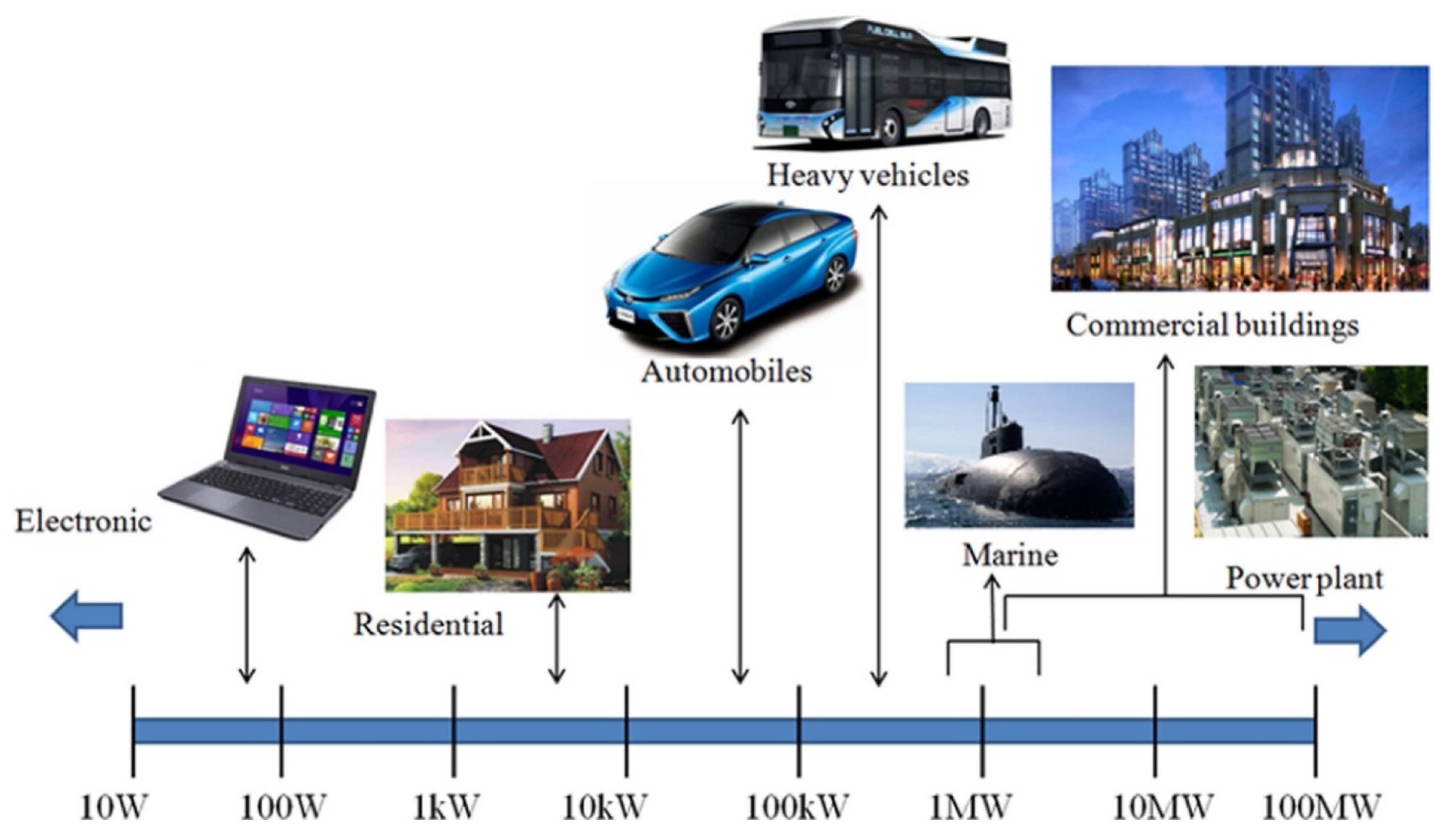
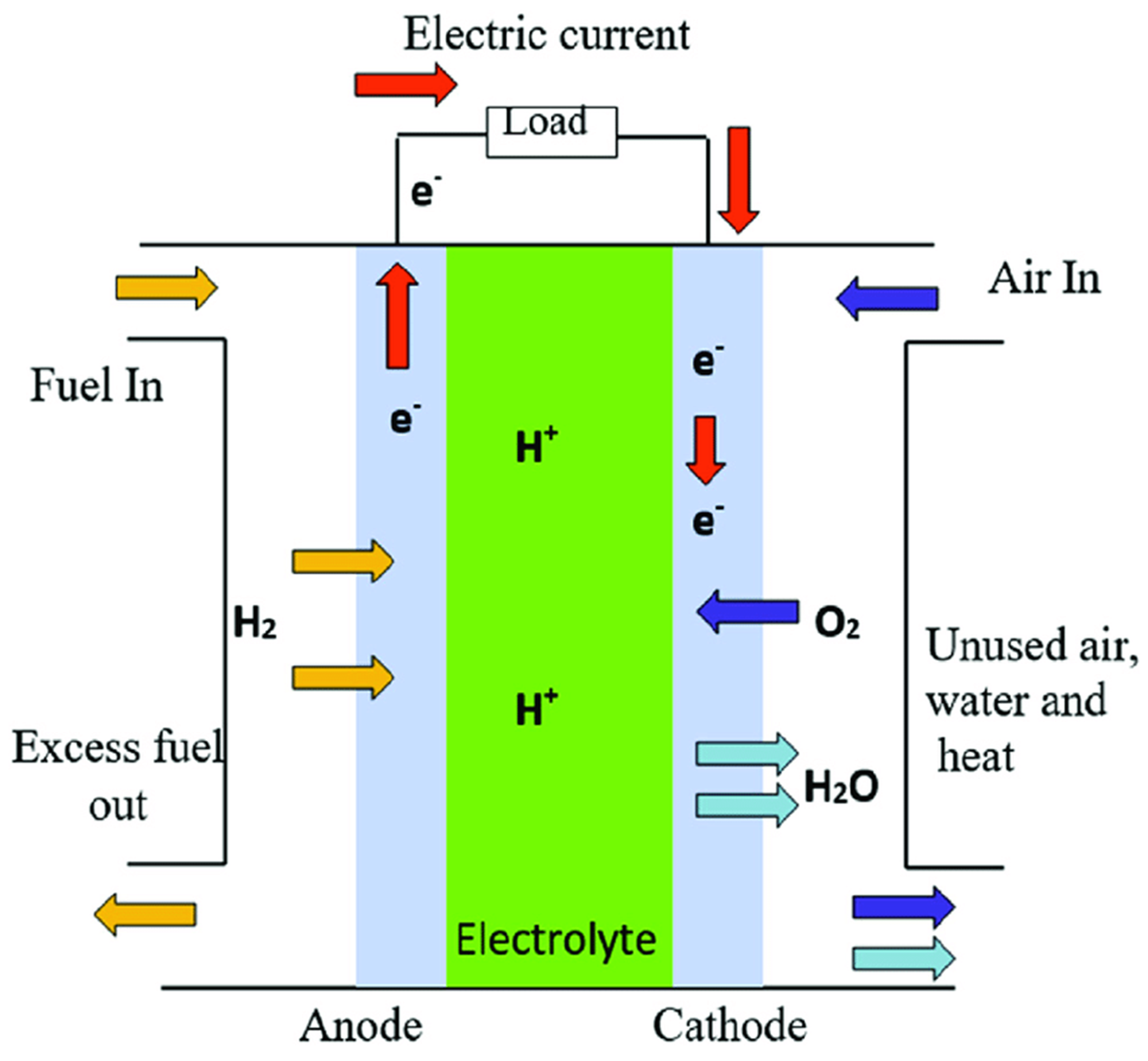
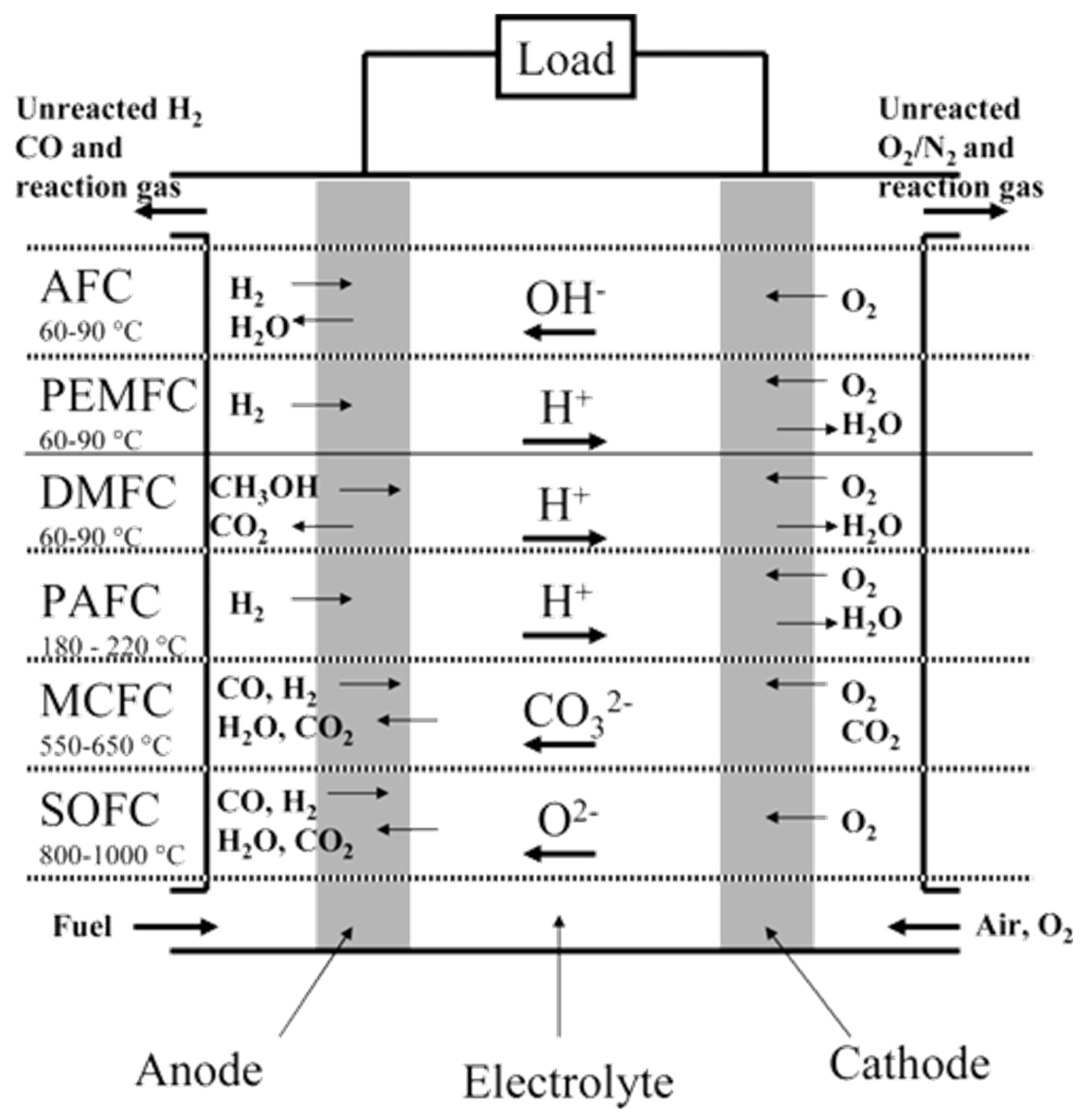

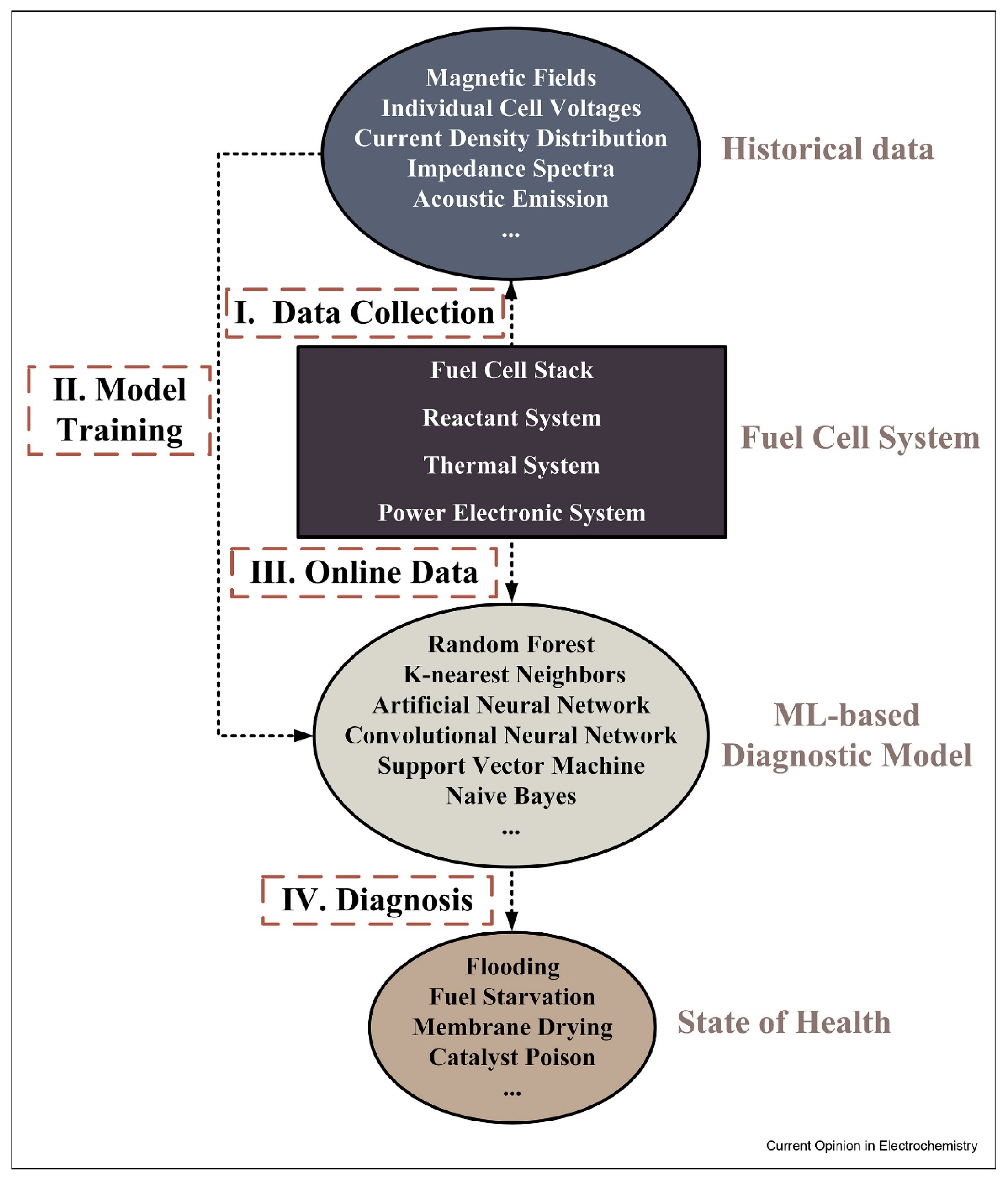
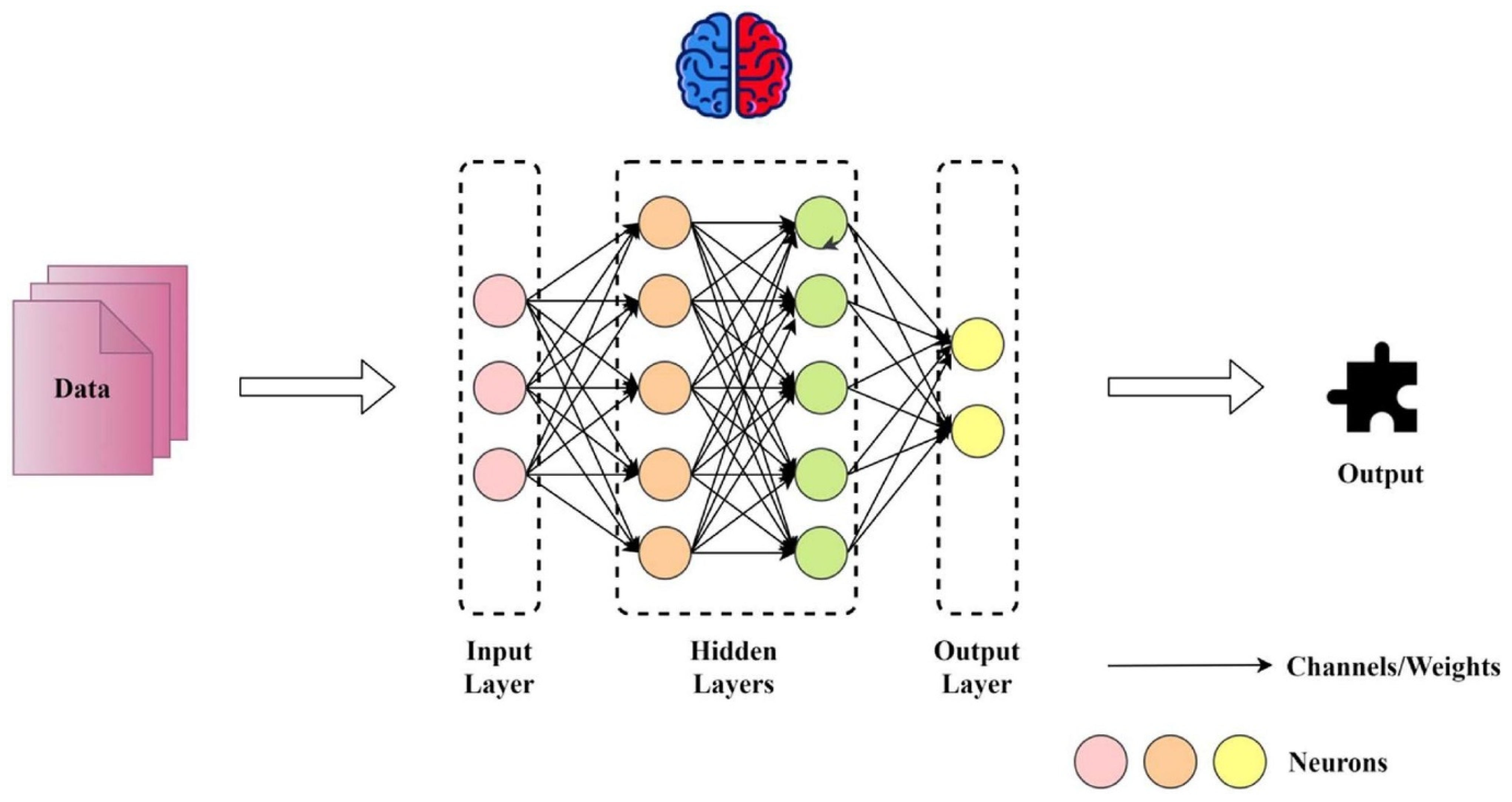
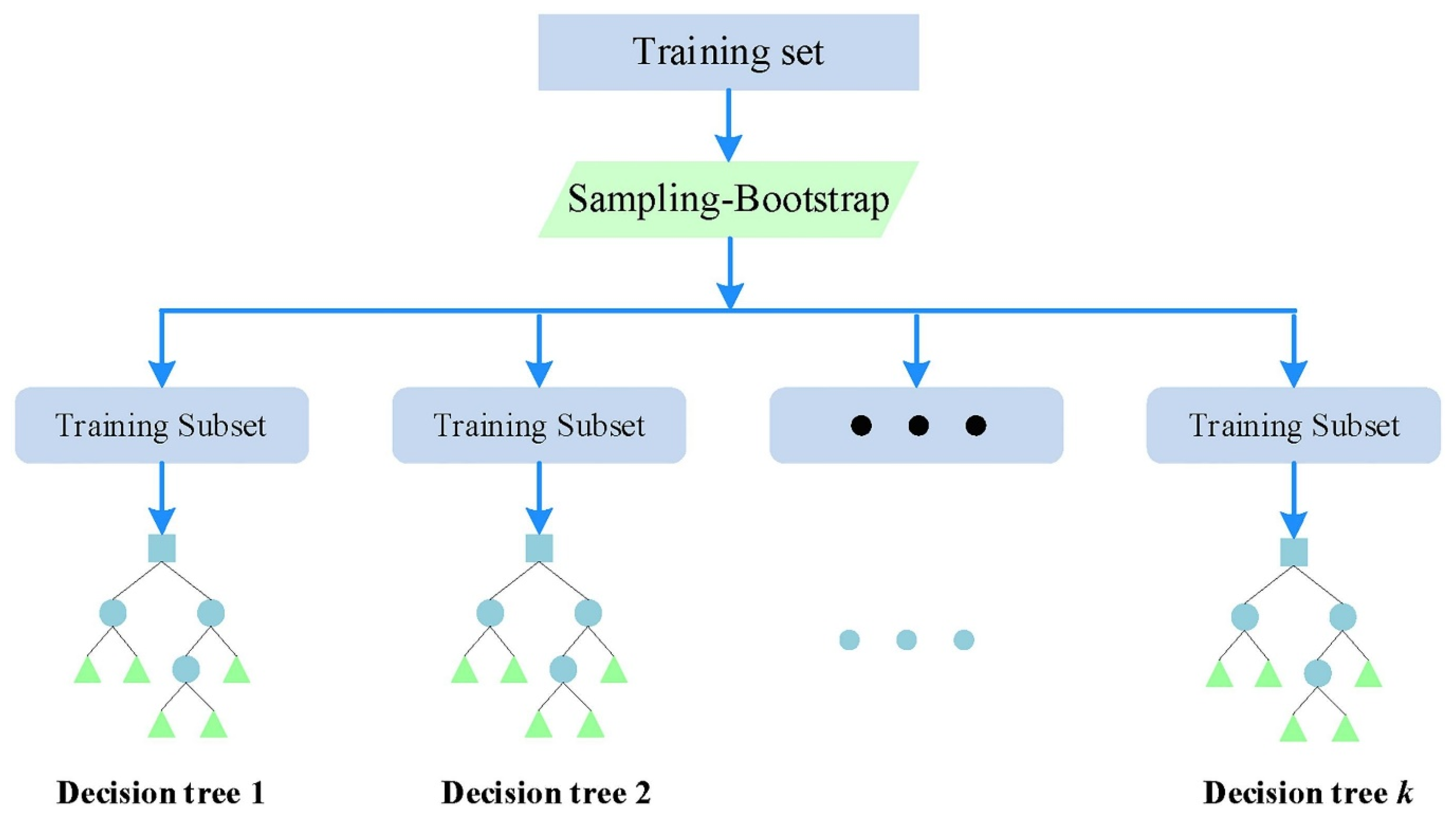
| Type | Anode | Cathode | Electrolyte | Working Temperature (°C) |
|---|---|---|---|---|
| AFC | Carbon (C)/platinum (Pt) catalyst | Aqueous KOH | Ambient—100 | |
| DMFC | C/Pt catalyst | Acidic Polymer | 60–90 | |
| PEMFC | C/Pt catalyst | Acidic Polymer | Ambient—90 | |
| PAFC | C/Pt catalyst | Phosphoric acid in SiC matrix | 150–220 | |
| MCFC | Ni | NiO | Molten Li2CO3 in LiAlO2− | 550–700 |
| SOFC | Ni-YSZ | LSM Perovskite | YSZ | 600–1000 |
Publisher’s Note: MDPI stays neutral with regard to jurisdictional claims in published maps and institutional affiliations. |
© 2022 by the authors. Licensee MDPI, Basel, Switzerland. This article is an open access article distributed under the terms and conditions of the Creative Commons Attribution (CC BY) license (https://creativecommons.org/licenses/by/4.0/).
Share and Cite
Kishore, S.C.; Perumal, S.; Atchudan, R.; Alagan, M.; Sundramoorthy, A.K.; Lee, Y.R. A Critical Review on Artificial Intelligence for Fuel Cell Diagnosis. Catalysts 2022, 12, 743. https://doi.org/10.3390/catal12070743
Kishore SC, Perumal S, Atchudan R, Alagan M, Sundramoorthy AK, Lee YR. A Critical Review on Artificial Intelligence for Fuel Cell Diagnosis. Catalysts. 2022; 12(7):743. https://doi.org/10.3390/catal12070743
Chicago/Turabian StyleKishore, Somasundaram Chandra, Suguna Perumal, Raji Atchudan, Muthulakshmi Alagan, Ashok K. Sundramoorthy, and Yong Rok Lee. 2022. "A Critical Review on Artificial Intelligence for Fuel Cell Diagnosis" Catalysts 12, no. 7: 743. https://doi.org/10.3390/catal12070743
APA StyleKishore, S. C., Perumal, S., Atchudan, R., Alagan, M., Sundramoorthy, A. K., & Lee, Y. R. (2022). A Critical Review on Artificial Intelligence for Fuel Cell Diagnosis. Catalysts, 12(7), 743. https://doi.org/10.3390/catal12070743








